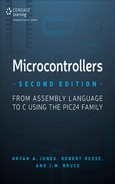Book Description
This completely updated second edition of MICROCONTROLLERS: FROM ASSEMBLY LANGUAGE TO C USING THE PIC24 FAMILY covers assembly language, C programming, and hardware interfacing for the Microchip PIC24 family, a recently updated microcontroller family from Microchip. Hardware interfacing topics include parallel port usage, analog-to-digital conversion, digital-to-analog conversion, the serial peripheral bus (SPI), the inter-integrated circuit bus (I2C), asynchronous serial communication, and timers. Assembly language programming is covered in the context of the PIC24 instruction set, and no initial knowledge of assembly language programming is assumed. Specific hardware interfacing topics covered are parallel IO, analog-to-digital/digital-to-analog conversion, pulse width modulation, timer usage for IO polling, and industry standard serial interface standards. Interfacing examples include external devices such as pushbutton switches, LEDs, serial EEPROMs, liquid crystal displays (LCDs), keypads, rotary encoders, external digital-to-analog converters, DC motors, servos, temperature sensors, and IR receivers. Master the PIC24 family with MICROCONTROLLERS: FROM ASSEMBLY LANGUAGE TO C USING THE PIC24 FAMILY
Table of Contents
- Title Page
- Copyright
- Dedication
- Acknowledgments
- About the Authors
- Contents
- Introduction
- PART I DIGITAL LOGIC REVIEW AND COMPUTER ARCHITECTURE FUNDAMENTALS
- PART II PIC24 µC ASSEMBLY LANGUAGE PROGRAMMING
- Chapter 3 Introduction to the PIC24 Microcontroller Family
- Learning Objectives
- Introduction to Microprocessors and Microcontrollers
- The PIC24 Microcontroller Family
- Data Transfer Instructions and Addressing Modes
- File Register Addressing
- Basic Arithmetic and Control Instructions
- A PIC24 Assembly Language Program
- The Clock and Instruction Execution
- Summary
- Review Problems
- Chapter 4 Unsigned 8/16-Bit Arithmetic, Logical, and Conditional Operations
- Learning Objectives
- Bitwise Logical Operations, Bit Operations
- Using the Status Register
- Using Shift and Rotate Operations
- Using Mixed 8-Bit/16-Bit Operations, Compound Operations
- Conditional Execution Using Bit Tests
- Unsigned Conditional Tests
- Complex Conditional Expressions
- Looping
- Summary
- Review Problems
- Chapter 5 Extended Precision and Signed Data Operations
- Chapter 6 Pointers and Subroutines
- Learning Objectives
- PIC24 Indirect Addressing Modes
- Using Subroutines
- The Stack and Call/Return, Push/Pop
- Implementing Subroutines in Assembly Language
- C Pointers and Arrays
- Stack Frames for Function Parameters and Local Variables
- Program Space Visibility and Global Variable Initialization
- Summary
- Review Problems
- Chapter 7 Advanced Assembly Language: Higher Math
- Chapter 3 Introduction to the PIC24 Microcontroller Family
- PART III PIC24 µC INTERFACING USING THE C LANGUAGE
- Chapter 8 System Startup and Parallel Port I/O
- Learning Objectives
- High-Level Languages versus Assembly Language
- C Compilation for the PIC24 µC
- PIC24 Startup Schematic
- ledflash.c—The First C Program for PIC24 Startup
- echo.c—Testing the Serial Link
- Datasheet Reading—A Critical Skill
- Configuration Bits
- Clock Generation
- Power-On Reset Behavior and Reset Sources
- Watchdog Timer, Sleep, Idle, and Doze
- The reset.c Test Program
- Parallel Port Operation
- LED/Switch I/O and State Machine Programming
- Interfacing to an LCD Module
- The PIC24E versus the PIC24F and PIC24H Families
- Summary
- Review Problems
- Chapter 9 Interrupts and a First Look at Timers
- Learning Objectives
- Interrupt Basics
- PIC24 µC Interrupt Details
- ISR Functions in C
- Change Notification Interrupts
- INTx External Interrupts and Remappable Pins
- Periodic Timer Interrupts
- Interrupt-Driven LED/Switch I/O
- Filtering Noisy Inputs
- A Rotary Encoder Interface
- A Keypad Interface
- On Writing and Debugging ISRs
- Summary
- Review Problems
- Chapter 10 Asynchronous and Synchronous Serial I/O
- Learning Objectives
- I/O Channel Basics
- Synchronous, Asynchronous Serial I/O
- The PIC24 UART
- Using the PIC24 UART with C
- Interrupt-Driven I/O with the PIC24 UART
- The RS-232 Standard
- The Serial Peripheral Interface (SPI)
- SPI Example: The MCP41xxx Digital Potentiometer
- SPI Example: PIC24 μC Master to DS1722 Thermometer
- SPI Example: PIC24 µC Master to PIC24 μC Slave
- The I2C Bus
- I2C on the PIC24 μC
- I2C Example: PIC24 μC Master to DS1631 Thermometer
- I2C Example: PIC24 μC Master to 24LC515 Serial EEPROM
- Ping-Pong Buffering for Interrupt-Driven Streaming Data
- Summary
- Review Problems
- Chapter 11 Data Conversion
- Chapter 12 Timers
- Learning Objectives
- Pulse Width Measurement
- Pulse Width, Period Measurement Using Input Capture
- Application: Using Capture Mode for an Infrared Decoder
- The Output Compare Module
- Pulse Width Modulation
- PWM Application: DC Motor Speed Control and Servo Control
- A PWM DAC
- Time Keeping Using Timer1 and RTCC (PIC 24H/F Families)
- Summary
- Review Problems
- Chapter 13 Advanced Hardware Topics
- Chapter 14 Operating Systems for Embedded Systems
- Chapter 8 System Startup and Parallel Port I/O
- PART IV APPENDIXES
- Index
